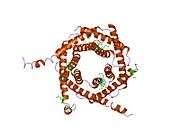TIMM9
Mitochondrial import inner membrane translocase subunit Tim9 is an enzyme that in humans is encoded by the TIMM9 gene.[5][6][7]
TIMM9 belongs to a family of evolutionarily conserved proteins that are organized in heterooligomeric complexes in the mitochondrial intermembrane space. These proteins mediate the import and insertion of hydrophobic membrane proteins into the mitochondrial inner membrane.[supplied by OMIM][7]
References
- 1 2 3 GRCh38: Ensembl release 89: ENSG00000100575 - Ensembl, May 2017
- 1 2 3 GRCm38: Ensembl release 89: ENSMUSG00000021079 - Ensembl, May 2017
- ↑ "Human PubMed Reference:".
- ↑ "Mouse PubMed Reference:".
- ↑ Jin H, Kendall E, Freeman TC, Roberts RG, Vetrie DL (Feb 2000). "The human family of Deafness/Dystonia peptide (DDP) related mitochondrial import proteins". Genomics. 61 (3): 259–67. doi:10.1006/geno.1999.5966. PMID 10552927.
- ↑ Muhlenbein N, Hofmann S, Rothbauer U, Bauer MF (Mar 2004). "Organization and function of the small Tim complexes acting along the import pathway of metabolite carriers into mammalian mitochondria". J Biol Chem. 279 (14): 13540–6. doi:10.1074/jbc.M312485200. PMID 14726512.
- 1 2 "Entrez Gene: TIMM9 translocase of inner mitochondrial membrane 9 homolog (yeast)".
Further reading
- Webb CT, Gorman MA, Lazarou M, et al. (2006). "Crystal structure of the mitochondrial chaperone TIM9.10 reveals a six-bladed alpha-propeller". Mol. Cell. 21 (1): 123–33. doi:10.1016/j.molcel.2005.11.010. PMID 16387659.
- Gerhard DS, Wagner L, Feingold EA, et al. (2004). "The status, quality, and expansion of the NIH full-length cDNA project: the Mammalian Gene Collection (MGC)". Genome Res. 14 (10B): 2121–7. doi:10.1101/gr.2596504. PMC 528928. PMID 15489334.
- Strausberg RL, Feingold EA, Grouse LH, et al. (2003). "Generation and initial analysis of more than 15,000 full-length human and mouse cDNA sequences". Proc. Natl. Acad. Sci. U.S.A. 99 (26): 16899–903. doi:10.1073/pnas.242603899. PMC 139241. PMID 12477932.
- Vial S, Lu H, Allen S, et al. (2002). "Assembly of Tim9 and Tim10 into a functional chaperone". J. Biol. Chem. 277 (39): 36100–8. doi:10.1074/jbc.M202310200. PMID 12138093.
- Rothbauer U, Hofmann S, Mühlenbein N, et al. (2001). "Role of the deafness dystonia peptide 1 (DDP1) in import of human Tim23 into the inner membrane of mitochondria". J. Biol. Chem. 276 (40): 37327–34. doi:10.1074/jbc.M105313200. PMID 11489896.
- Bauer MF, Rothbauer U, Mühlenbein N, et al. (2000). "The mitochondrial TIM22 preprotein translocase is highly conserved throughout the eukaryotic kingdom". FEBS Lett. 464 (1–2): 41–7. doi:10.1016/S0014-5793(99)01665-8. PMID 10611480.
This article is issued from
Wikipedia.
The text is licensed under Creative Commons - Attribution - Sharealike.
Additional terms may apply for the media files.






